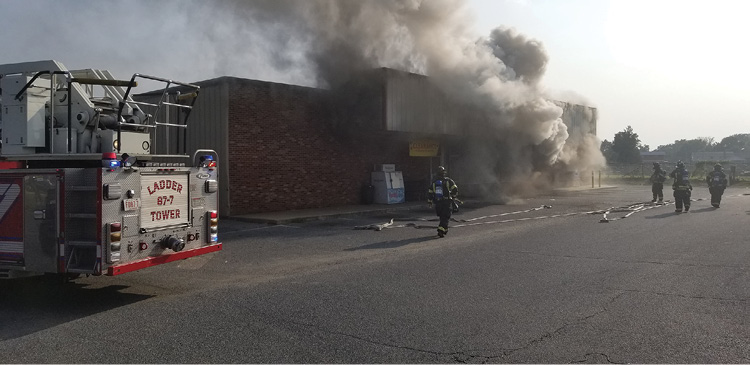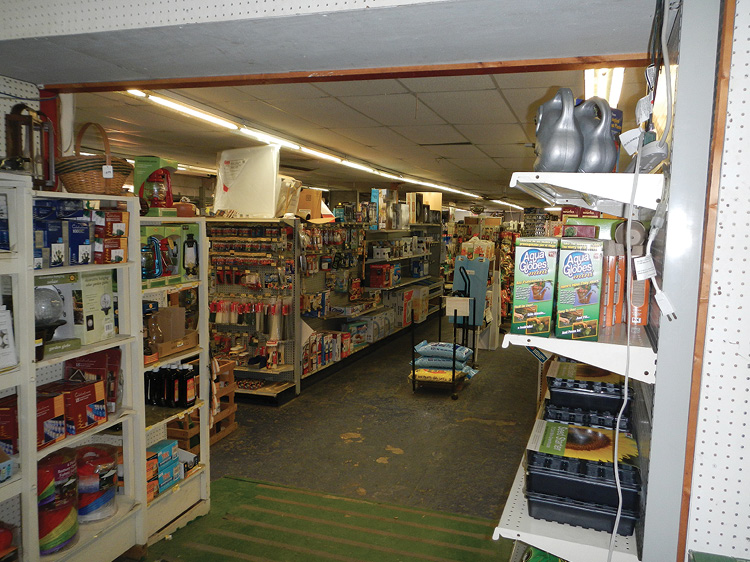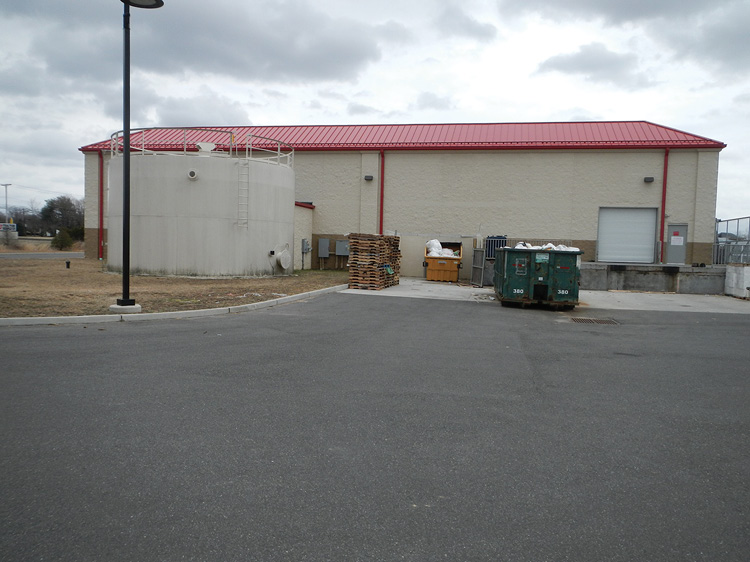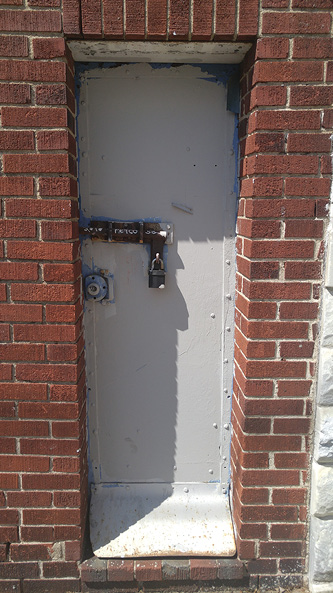
By Aaron J. Heller
I have written and presented on firefighting strategies and tactics in big box stores in the past; however, there have been highly publicized and critiqued fires in these types of buildings that can increase our knowledge and make us better prepared for these events. The focus of this article is the more localized hometown box stores, which exist in all communities, and the hazards they present for firefighters.
I recently attended a postfire review of a fire in a local Family Dollar Store in Seaford, Delaware (photo 1). It was extremely well presented and provided much helpful information for the crews involved and the invited guests. It motivated me to disseminate as much information on the topic as possible.

(1) Photo by Jack Wilson.
Definition
Since we have no definitions for these buildings, let’s see how we can categorize them. When looking at my district, I found several businesses that are not big box store chains such as Lowe’s, Home Depot, Wal-Mart, and Kohl’s. They are a local lumberyard, a hardware store, a dollar store, a grocery store, an auto parts store, and a thrift shop, to name a few (photos 2-3). They can be defined by their square footage, which generally is less than 20,000 square feet. This information will enable you to adjust your standard operating procedures (SOPs) and adapt your training program for these smaller commercial structures. These buildings may be anything from wood frame to noncombustible construction. Tactically, this is extremely important to know.
RELATED
Firefighting in Big Box Stores
‘Big Box’ Store Fire: Lessons Learned
Large-Area Search: Lessons Found in a ‘Big Box’
Preplanning
Preplanning these structures is vital. Several years ago, I attended a class on building recon presented by Former Deputy Chief Jack Murphy, Leonia (NJ) Fire Department, at FDIC International that reinforced the value of a solid building preplan to everyone from the incident commander (IC) to the line firefighter. By conducting quality building recon during construction and renovations, our crews can get a great picture of the challenges they will face from forcible entry obstacles, areas of potential fire travel, ventilation concerns, and anything else that may hamper firefighting operations.

(2) Dollar General (Photos 2-6 by author.)

(3) Suit World.
Preplanning doesn’t always have to be a formal crew or an inspector walk-through. How many times do you go to the local hardware store, dollar store, or grocery store during your weekly or monthly schedule? Do you take a mental picture of these buildings? Over the course of my career, I have found that it is second nature to size up every building I enter, be it on duty or during my time off. I look at the entrances/exits, aisle layouts, if it is protected or alarmed, the type of building construction, and any unique designs or challenges if we were fighting a fire in the building. To take this from informal to formal, you can always take a few pictures of things of interest or importance to your crews and share them on the next shift. Since we all carry our phones everywhere we go, make a few notes on your observations and transcribe them to your preplan software during the next shift or fire company drill night (photo 4).

(4) Interior aisles of a box store.
Tactics and Resources
You must understand the tactics and resources necessary to combat these fires. If a department undervalues these key components, firefighter injuries and large fire losses will be inevitable.
Response Model
The first consideration is your department’s response model. Planning for the actual number of personnel and apparatus you will have on location in the first five to 10 minutes is key. If your box alarms or SOPs are based on hopes and dreams instead of what you actually get at 2:00 p.m. or 2:00 a.m. on a Thursday, you are already placing yourself behind the eight ball and setting the department up for failure.
As far as resources go, obviously firefighters and rigs are our greatest assets; but without a water supply, we can do only so much. Understanding your local water system’s capabilities is very important. If you operate in an area with hydrants, do you know your flows and can you get the local water company to turn on the pumps necessary to maximize your output? If you are in a more rural setting, tankers/tenders must be included in your response plan and all personnel should know how to maintain the necessary fire flow to make a difference on these larger fires (photo 5).

(5) The water tank at the rear of the building.
Like anything else on the fireground, being good at this requires steady training. Committing members to interior operations without a solid water supply is dangerous and is rarely recommended.
Construction and Contents
Construction and contents definitely affect tactics. Both will present challenges based on the level of fire involvement on arrival of the first due. This is where the IC’s knowledge of the preplan is extremely critical. An officer should plan from the top and work down.
Knowing the roof structure is important. For example, many newly built dollar stores are lightweight metal construction consisting of wood or lightweight steel structural members covered by a thin-gauge metal skin. The roofs are normally wood truss, steel truss, or lightweight steel beams covered by a layer of q-decking or lightweight steel sheeting. The key word here is “lightweight”! Knowing this is a common roof construction tells me immediately that committing personnel to vent this roof may be a bad decision unless it’s done from a tower ladder bucket. As an engine officer, this tells me to expect a tougher interior push since we may not get that vertical ventilation lift.
In older stores, it is common to find traditional, ordinary, or wood-frame construction with plywood or even wood-planked roofs. Also of great concern must be those buildings that are in less than optimum condition. Be aware of deteriorating roof structures or those that have been patched repeatedly. Be aware of the amount of flame impingement on roof structures if you intend to work on or under them. If the store has a drop ceiling or a void above, have the interior crews open the voids and use a thermal imaging camera. As you know, unchecked fire spread above you is a tragedy waiting to happen.
Exterior walls can also encompass the gamut of construction methods. They range from noncombustible tilt-up to masonry block, lightweight metal sheeting, and basic wood frame. Again, the fire department should have noted this in its plan reviews, during the construction period, or at least by the time construction was completed and a certificate of occupancy was issued. Knowing the wall construction helps personnel understand the effects of fire conditions and the degree of difficulty they will encounter if they should have to create additional openings.
Basement or Cellar
Another important feature in many mid-size box stores or commercial occupancies is the presence of a basement or a cellar. Although less common in new construction, older, renovated buildings have experienced these fires, which present hazards of their own.1 Basements and cellars in these structures pose several obstacles that need to be addressed prior to the fire. They include the type and amount of storage and how neat and orderly the housekeeping has been. Additionally, knowing the entrances and exits is paramount. This allows for a faster line deployment, search, and retreat if conditions deteriorate.
In many cases, the utilities are in this location. Gas, oil, electric, and water controls must be addressed early in the fire. If you encounter problems in a commercial basement, immediately notify the IC, who must be prepared to pull operating personnel out if conditions hamper progress.
Water Supply
As stated earlier, a sufficient water supply is crucial at these fires. If you encounter a small incipient fire, your booster tank of 500 to 1,000 gallons should be enough to make a good initial attack on the fire, especially in an interior attack. Another important tactical consideration is the engine company’s responsibility to supply the building’s sprinkler system. This should be in your SOPs, and all engine companies on the run card must know of this responsibility. However, if you have more fire spread than anticipated, the IC may need to amend the incident action plan (IAP) and possibly the strategy.
Line Selection
Line selection is often a hotly debated topic, but poor line selection will almost always lead to the creation of a new parking lot! Research has proven that big water on the seat of a commercial fire is the way to go. The knockdown power along with the reach and penetration of a properly flowing 2½-inch handline gives interior crews their best opportunity to confine, control, and extinguish an advancing fire in these structures. There are plenty of case studies that show where a smaller-diameter line was stretched initially, companies failed at playing catch-up for the rest of the fire. Remember, after a solid knockdown, you can always back down to a 1¾-inch line for more maneuverability and mop-up work.

(6) The exterior locked door.
If met with a large fire on arrival and if the decision is to start with an exterior attack to darken the fire and move in as conditions allow, the larger line is even more important. Therefore, it is important that our rigs be set up to make a timely stretch and that we train firefighters to do it with competence and confidence. If the fire is beyond your capability on arrival and a defensive strategy is called for, master streams from aerial apparatus, deck guns, and portable monitors may be the best option. This is acceptable if the conditions warrant this type of attack; however, it should not be your default tactic for everything that is not a department’s bread-and-butter call.
Ventilation
At all fires, several traditional truck company duties are required, but they are even more pronounced when dealing with stores of this type and size. Depending on the size of the structure and the location of the fire in it, ventilation will most likely be more difficult than in the typical one- and two-family dwellings. Before committing personnel to the roof, consider whether the construction and extent of the fire will permit successful roof operations. If you order roof ventilation, have the crews ensure the roof’s stability; make their vent holes; and get back to the safety of aerial devices, portable ladders, or adjoining structures. Use existing aspects of the building such as skylights and roof scuttle openings to aid in a more rapid ventilation operation. Ventilation through large windows and garage doors is also an option to consider in these types of fires, but it must be done in coordination with the engine companies operating the handlines. Do not disregard the tremendous impact ventilation will have on a progressing fire. Proper ventilation can give operating firefighters and potential occupants a great deal of relief, but it can also prove deadly if it is done incorrectly.
Forcible Entry
It is likely that you may encounter various types of doors and locking devices (photo 6) in these stores. They can range from commercially sold locks and security devices to some of the most ingenious homemade systems. The building owners are less concerned with code compliancy and firefighter or occupant safety than with protecting their investment. Our firefighters must be skilled with all their forcible entry tools and know how to use or defeat the locking systems they may encounter. Keep in mind that rotary saws and hydraulic spreaders may save a great deal of time. Proficiency with these tools is a must.
Search
Searching in these buildings necessitates personnel; coordination; and an understanding of the structure, its contents, and the building layout. This is a prime example of why firefighters must be trained to do large-area search. Search ropes are important for this operation; firefighters must train with them for a timely and successful search. These tactics, including what to do when victims are found, must be drilled on, and all personnel must be working together as a team.
Commanding fires in these occupancies is not for the faint of heart. At any hometown box store fire, an IC may need to call on all incident management and command and control training and resources. A solid command structure is needed, and the IAP must be followed. Freelancing at these fires is a recipe for disaster.
Hometown box stores are clearly a hazard that almost every community faces. Despite the challenges and hazards they pose, a well-trained, equipped, and—dare I say—aggressive fire department can overcome these issues and successfully mitigate these fires.
Author’s note: Special thanks to Chief Jack Wilson of the Seaford (DE) Volunteer Fire Company for sharing his knowledge and information on this important topic.
Endnote
1. “Father’s Day: Its Special Meaning for the Fire Service, Joseph Pronesti, Fire Engineering, June 2017; (https://emberly.fireengineering.com/articles/2017/06/fathers-day-its-special-meaning-for-the-fire-service.html).
Aaron J. Heller is a 34-year member of the fire service and a captain in charge of training for Hamilton Twp. (NJ) Fire District #9. He has a B.S. degree in fire science from Columbia Southern University. He is a New Jersey level 2 instructor and presents at several training events. He is a co-host of Fire Engineering’s Humpday Hangout on training. He owns On Scene Training Associates, LLC.

